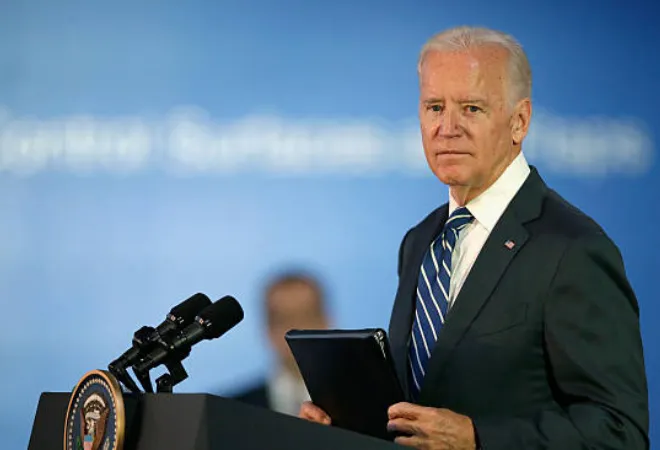-
CENTRES
Progammes & Centres
Location
The IRA, especially its climate and tax components, could prove to be a masterstroke for the Democrats before the mid-term elections.

The United States (US) in recent times has been witnessing a sequence of important legislations being passed. The Senate on 27 July passed the US$280-billion Industrial Policy Bill to counter China by boosting semiconductor manufacturing. Other similar steps taken earlier by the Biden administration include the US$1.9-trillion stimulus plan in March 2021 and the US$1-trillion infrastructure bill signed into law in November 2021.
Perhaps most importantly, on 16 August the Biden administration signed a set of bills dealing with climate, tax, and health into law. The law is being seen as a step by the Biden administration to prepare the US “for tomorrow”. The Inflation Reduction Act (IRA) of 2022 which could cost the US government a whopping US$700 billion has three main objectives: Fight climate change; reduce the cost of healthcare for American families; raise taxes for rich Americans. It sets out US$369 billion for the fight against climate change and ensuring energy security through clean energy provisions such as tax credits for electric vehicles and fuels, promotion of large-scale investments in domestic manufacturing of clean technologies and environmental justice. Amongst the specifics, the law will make corporations pay a minimum tax and raise a tax on those earning above US$400,000. The law also makes medical exceptions for senior citizens in the US by capping their out-of-pocket expenditure on drugs at US$2000 and reducing the health insurance premiums of those under the Affordable Care Act by US$800. Aimed at a rapid clean energy transition, the law focuses on industrial energy, fuels for aeroplanes and ships, and the construction of a fusion energy science research facility by allocating half a billion dollars for the project.
The climate component of the Act seeks to fight climate change by ensuring lowering emissions by up to 44 percent by 2030 based on current US emission trends. This would translate to an overall reduction in emissions by 37–41 percent below 2005 levels and is, therefore, consistent with the US international climate commitments to cut greenhouse gas emissions to half (50 percent) of the 2005 level by 2030. These commitments are part of the Nationally Determined Commitments (NDCs) under the Paris Climate Accord which are essential for the US to achieve net-zero emissions by 2050.
Aimed at a rapid clean energy transition, the law focuses on industrial energy, fuels for aeroplanes and ships, and the construction of a fusion energy science research facility by allocating half a billion dollars for the project.
The IRA provides a political fillip to the Biden administration after a recent US Supreme Court ruling placed restrictions on the federal government’s authority to curb emissions from power plants through sweeping legislations. Politically, the Act seeks to boost the chances of the Democrats in the midterm elections scheduled for November. If these legislative steps indeed help the Biden administration win in the midterm elections, the Democrats will control the US Congress for two more years until the next presidential elections.
At the international level, the Biden administration seeks to enhance Washington’s global leadership on climate. With the IRA and its climate-related clauses, the Biden administration has sought to re-energise the climate leadership led by Special Presidential Envoy for Climate, John Kerry. At the centre of the US efforts to lead the climate discourse is increasing its competitive edge against China on climate technologies and clean energy equipment production. In so far as international competition with China is concerned, the IRA promises a mixed bag. In the days leading up to the IRA, the US was seen as playing catch up to China’s massive spending on clean energy technologies.
In 2021 alone, China spent US$300 billion compared to US$120 billion spent by the US. The IRA intends to reset the clock on climate-related investments in the US by combining both federal and private investments. A large chunk of the funding within the IRA is allocated for supporting green industries domestically. As such, the IRA has been seen as a positive step that could even out competition with China in clean energy industries and technologies. However, just days ahead of Biden signing the IRA, China had suspended climate talks with the US due to Nancy Pelosi’s visit to Taiwan. This abrupt halt in climate negotiations between two of the world’s biggest emitters and economies could potentially push back global climate gains—especially the realisation of the 2015 Paris Climate deal commitments—as well as limit the gains that the US seeks in international climate leadership through the IRA. Through the IRA, the US also seeks to reduce dependence on Chinese supply chains in the long run and emerge as the topmost supplier of clean energy equipment for solar, wind, and batteries.
The IRA intends to reset the clock on climate-related investments in the US by combining both federal and private investments. A large chunk of the funding within the IRA is allocated for supporting green industries domestically.
Amongst the criticisms of the law are that its overall financial commitment is well below the initially envisaged US$3.5 trillion to modernise the economy and reduce dependence on fossil fuels, as well as cut medical bills of the average American family. In addition, the IRA requires the auction of federal land and water for oil and gas before auctioning federal land and water for renewable energy projects. Biden’s recent temporary legal victory in once again pausing energy leasing on federal lands and waters may have provided a political reprieve even as 13 states led by Louisiana had sued the Biden administration to start leasing federal land and water for fossil fuel leasing. President Biden had imposed a ban on such leasing just a week after assuming the President’s office.
As the mid-term elections approach in the US, the Biden administration has sought to rebuild its domestic credentials, reposition the US in great power competition with China, and restore its influence in the world with a slew of legislative steps. Boosting that sentiment, the new climate laws seek to underscore the gains made in his initial promise of “putting the climate crisis at the centre of United States’ foreign policy and national security.” It promises to enhance US competitiveness abroad and increase demand at home by promoting and subsidising clean energy technologies. In some ways, the IRA seems to be an attempt at ‘Make in America’, Washington’s own version of the popular policy which countries like China and India have.
Yet, the immediate focus of the IRA remains primarily domestic, at least in the short term. The Biden administration has targeted young Americans, Black, and Hiic communities in the US by promising job creation, lowering health care costs and costs for small businesses, taxing the rich, and providing affordable clean energy options over time. The IRA, especially its climate and tax components, could prove to be a masterstroke for the Democratic Party, before the mid-term elections.
The views expressed above belong to the author(s). ORF research and analyses now available on Telegram! Click here to access our curated content — blogs, longforms and interviews.

Vivek Mishra is Deputy Director – Strategic Studies Programme at the Observer Research Foundation. His work focuses on US foreign policy, domestic politics in the US, ...
Read More +